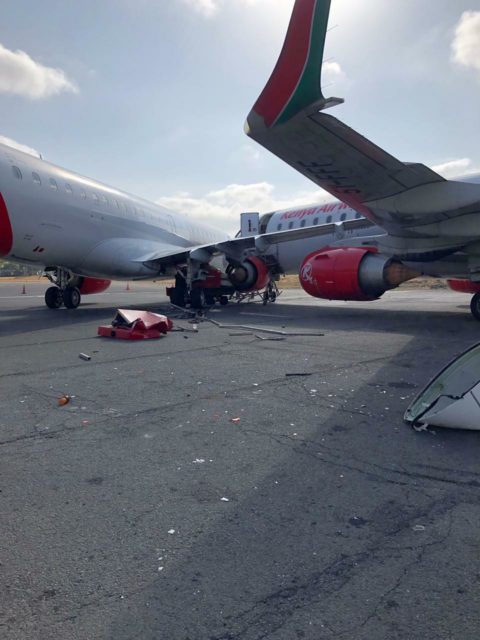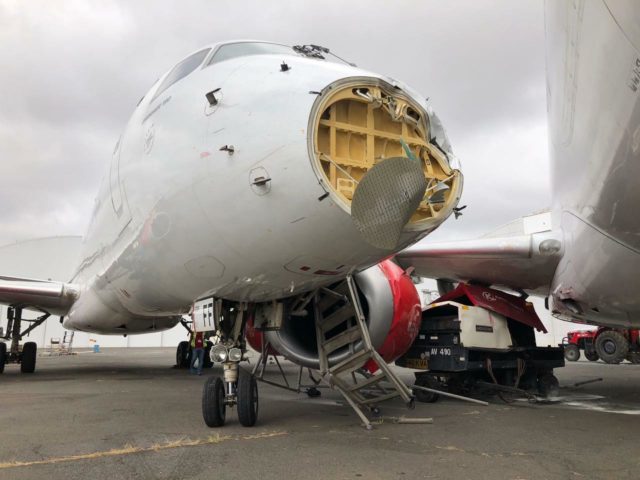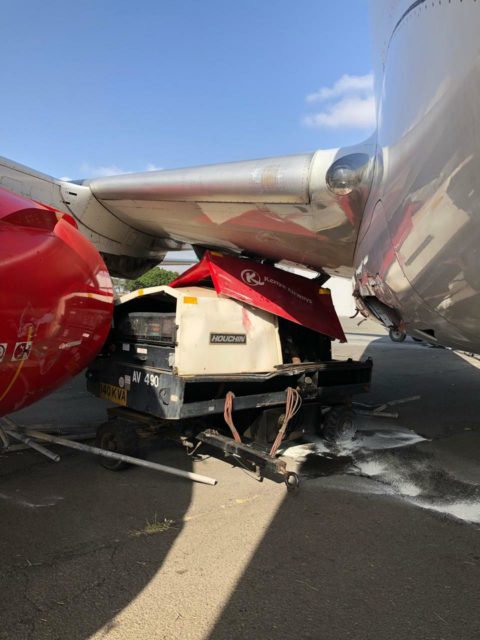Ground Collision at Nairobi
Two regional jets collided at Jomo Kenyatta International Airport in Nairobi last Saturday (9 Feb 2019).

Both passenger jets were Embraer 190 owned by flag carrier airline Kenya Airways and were scheduled for routine maintenance.

Apparently, one of the aircraft was in the process of a technical engine maintenance check when it “jumped off” while on a ground run in the hangar (I think they mean jumped the chocks?). The crew managed to steer the moving aircraft out of the hangar without collision but then rammed another Embraer 190 parked on the apron.

It probably would have been cheaper to have just let it hit the hangar walls.

These pictures are said to have been posted by someone on the scene to social media groups but I was unable to find the original source.
Kenya Airways immediately released a statement
Nairobi, February 9, 2019….Kenya Airways would like to confirm an incident involving two of its aircraft Embraer 190 on Friday night, 8th February 2019. The incident occurred during a standard technical engine maintenance check at the hangar that caused movement of one of the aircraft hence the impact.
Both planes were not in operations at this time therefore no passengers were involved. The airline can confirm that there are no injuries reported to any of its maintenance personnel following this incident.
The two aircraft involved in this incident got substantial damage and have since been withdrawn from service for full investigations. During such incidences, Kenya Civil Aviation Authority (KCAA) and Kenya Airways Safety team are required by law to carry out full investigations and furnish a full report. This process is currently on going and once complete, repairs on the aircraft can commence.
Both planes were scheduled to return to service in the next few days hence no disruption to normal operations.
Kenya Airways shall advise should there be any impact on our operations.
Kenya News Alerts TV broadcasted a video of the damage on the scene.
There were no injuries. An investigation is in progress.








ASN (https://aviation-safety.net/database/record.php?id=20190209-1) embeds the “Kampala Metro” Facebook page, which credits David Maina Ndung’u for the photos.
Oh, nice! Thank you for finding that!
“Jumping off”, yes I would put my money on “chocks”.
But it would require a very high amount of power to do so.
I flew a Learjet 25D, 5N-ASQ, in Nigeria (no, not in the ‘sixties, this was many years later). Still PIC under supervision, we had the engines already running when the ground crew disappeared to handle another aircraft. They had forgotten to remove the chocks. The checkpilot told me just to release the brakes and add power yes, the lear was so powerful that she lifted herself off and over the chocks. Mind, even in the tropics it would climb at 8000 feet per minute, and maintain more than 5000 fpm until well out of FL 330 and doing 300 kts IAS. A very potent little machine. It was developed from a Swiss designed fligher, I believe if I remember well, the P16 The problem was that it was very noisy and, unless one could get it up to and above FL 370 it would gobble up fuel.
If we had a long taxy, we could burn 500 lbs of fuel before even getting airborne, but it was a magnificent aircraft to fly.
But I digress.
What I wanted to say is that to get a jet aircraft to jump the chocks a very high power setting is needed.
What in the name of…. were these mechanics doing?
Assuming that the story has not been changed, somewhere down the line, it is not even normal practice to start up an aircraft, ANY aircraft, inside a hanger.
A high power run-up? Inside a hanger? It sounds absolutely mad to me.
I have the strange feeling that there is more to this story.
For those aviation ‘geeks’ who want to look it up: After I had left, the aircraft crashed. Listed as a “landing accident”. What happened was that one engine malfunctioned, resulting in a “runaway”, an uncontrolled overspeed. The engine, whilst in the process burning itself out, will deliver far more than the normal rated power. But to the crew, it will feel as if the other engine, still operating normally, has failed.
The Lear was a “hot ship” and on approach tended to do a bit of a “dutch roll”. If the pilot tried to counteract it, (s)he would only make it worse, the best action was to keep the ailerons steady and it would sort itself out.
But this type of aircraft requires a good bit of concentration on approach and if it suddenly yaws, the first instinct would be to assume an engine failure – and with that, shutting down the good one.
The performance of the 20-series Lear on one engine still was good for nearly 2000 ft/min climb. But here we are, on finals, gear and flaps down when it happens. The first, instinctive reaction would be to shut down the failed engine. This 25D was delivered new in 1981 and old-generation technology. The cockpit was narrow – a standard joke was: What is the difference beween a learjet captain and a first officer? Answer: the captain’s head leans permanently to the right, the first officer’s to the left. The instruments were also small, no fancy electronics. The autopilot did not even have an altitude pre-select mode. So shutting down the good engine results in flying on the malfunctioning one that, in the last minute of its life, spits out far more power than it should, power that cannot be reduced. So the aircraft yaws, the crew don’t have enough rudder to stop it.
The crew did a fantastic job under the circumstances, everyone got out.
Okay that was my “encore”.
“Both planes were scheduled to return to service in the next few days hence no disruption to normal operations”
Really??!! They must be “glass is always full”, king of people…
Starting in the hangar? What kind of idiots are these? At such a high power setting that the aircraft jumped the chocks? I say again, what kind of idiots are these?
“IN” the hanger may have been a typo, a bit further it reads “at”. But in any case, as events have proven, it is not a really bright idea to do a high power run in a congested parking area.
The Citation 500 I once flew was nearly blown away (at Milano-Malpensa) by an Alitalia 747 that did a high power run-up. I managed to jump in the aircraft and cut in on ATC conversations with a “break-break” to tell the Jumbo crew to reduce power. It was close call, even though there was no damage.
“The planes were scheduled to return to service…” Rich, that. they may have been SCHEDULED but I am absolutely sure that it took more than a “few days”.
Kenya Airways, to be fair, do not really have a bad reputation.
I am less sure about Kenya Airways. We had a very bad experience with them a couple of years ago when Nairobi Airport burned down and we were stranded in Zanzibar for three days. They were completely and utterly clueless. We eventually paid a real fortune to fly to Dar es Salaam and then catch an SAA flight to Jnb. Kenya AIrways could not have cared less. Nairobi Airport, when we passed through a few days before the fire, was a visible death trap. I would not fly with them again. I know the airport and the airline are separate but there is a funny culture about both. And don’t get me started on Precision Airlines.
Neil, that is news to me. Mind, I was only in Nairobi once, in Citation that I flew myself But then, when I was flying with Ryanair I was supoosed to depart from Kerry, in Ireland to Luton. The entire south of the UK and Ireland was fogged in, not a hope to land anywhere near. We probably would have had to divert to Belfast. All ground staff had gone home before we even had started the engines. It was quite probable that there would not have been anyone from the company to meet us at Belfast, let alone organise transport and hotels. So I took the decision myself to offload the passengers and postpone the flight until the next morning early 07:00..
This worked very well, all except one passenger showed up the next morning, but if I had not taken the initiative myself the treatment of the passengers would not have been much better than what you describe.
They admit to “substantial damage”, but claim “Both planes were scheduled to return to service in the next few days hence no disruption to normal operations.” It’s hard to judge one way or another from the photos, but I wouldn’t assume either plane will ever be airworthy, let alone being able to “return to service in the next few days”. Automobiles are reinforced to provide some protection against being hit from the side (sometimes colorfully called “T-boning”); I would not expect such reinforcement in airplanes, so the engine of the moving plane might just have punctured the skin of the parked plane or might have bent its skeleton (behind/below the captain’s seat) more than could be safely repaired — and if it did that kind of damage, the moving plane’s wing skeleton would also have been stressed.
Rudy — I don’t find detailed specs on that family of aircraft (in a cursory search), but I’d be surprised if it were as hot as a Lear; from what I read, the capacity for really high power can affect fuel economy even in normal operations, and economy is the name of the game for fare-carrying aircraft these days. I suspect “jumped the chocks” is bafflegab for “we just dropped the chocks on the hanger floor instead of setting them properly”, or maybe even “we didn’t bother with chocks, figuring the brakes would be enough, but nobody can prove it against us” — but yes, starting an engine inside a hanger sounds like a damnfool stunt. It will be interesting to hear what facts come out of this mess.
Chip,
We will be treated to another episode from Sylvia’s inexhaustible repertoire, but just to get back to your comments:
I was a commercial pilot for about 40 years, from 1969 until 2009.
And believe me, one look at the photos tell me: those aircraft were SEVERELY damaged. As you mentioned yourself, it is not just a matter of the engines and the skin, but all components underneath need to be examined for stress related damage. Experts from the factory will have to examine whether components like wing spars could be subject to metal fatigue. Remember the DC 10 where non-approved maintenance practice, a short-cut exchanging an engine, caused fatigue in the mountings and led to an engine literally flying up and over the wing, resulting in a slat being pushed in, and an uncontrollable stall?
Regarding “chock jumping”: power high enough to cause a parked aircraft quite literally to “jump” over chocks placed in front of the main wheels.
The Lear accident: it came up when I “googled” 5N-ASQ. I was not the pilot, I had left to fly Dr. Tony Ryan’s Corvette EI-BNY.
And I think “inside” the hanger was a typo, a bit further is reference to it having been outside the hanger. Still, no excuse for a high power run-up on an apron full of parked aircraft. Especially not if the mechanics do not know how to steer or stop it.
OK Sylvia, let it rip ! Enough said about this.
Oh, btw: fuel economy. The aircraft will need to fly at a speed where the speed of the exhaust will be as near to the forward speed of the aircraft as possible, or else fly very high.
The 20 series Lear was a straight jet, no fan at all.
A lot of noise and extremely high fuel flow below anything like 37000 feet (FL 370). So we usually, even on a short trip, cruised at and above that level.
A fan does two things: It reduces the speed of the outflow gases. This is achieved by directing a mantle of slower moving air around the main core of the engine, using a large fan. The actual exhaust gas still has a high velocity, but it no longer is the main component that provides the thrust, at least not at lower altitudes. At higher levels the ratio changes but then the air resistance reduces so there will be a different balance.
The second advantage: the high velocity gas being pushed out of a straight jet engine streams directly into air with a very much lower speed. Where the two meet, violent ripples, turbulence, causes the crackling sound that once made jet engines unpopular and led to all sorts of complicated noise abatement procedures to reduce the impact on the population living below. The BAC 1-11 was equipped with Rolls-Royce Spey engines. They were older generation fan engines, their bypass ratio was much lower than what is usual now. We would climb as quickly as possible, when approaching the noise level measuring spot (kindly printed on the Jeppesen SID charts) we would power back and allow the aircraft to drift pass that spot, after which we would open the cans again and continue the climb.
The large fan engines of today may even have triple spools, allowing the air to reduce speed (for economy) an at the same time adjust the velocity of the gas to cause less turbulence and therefore far less noise.